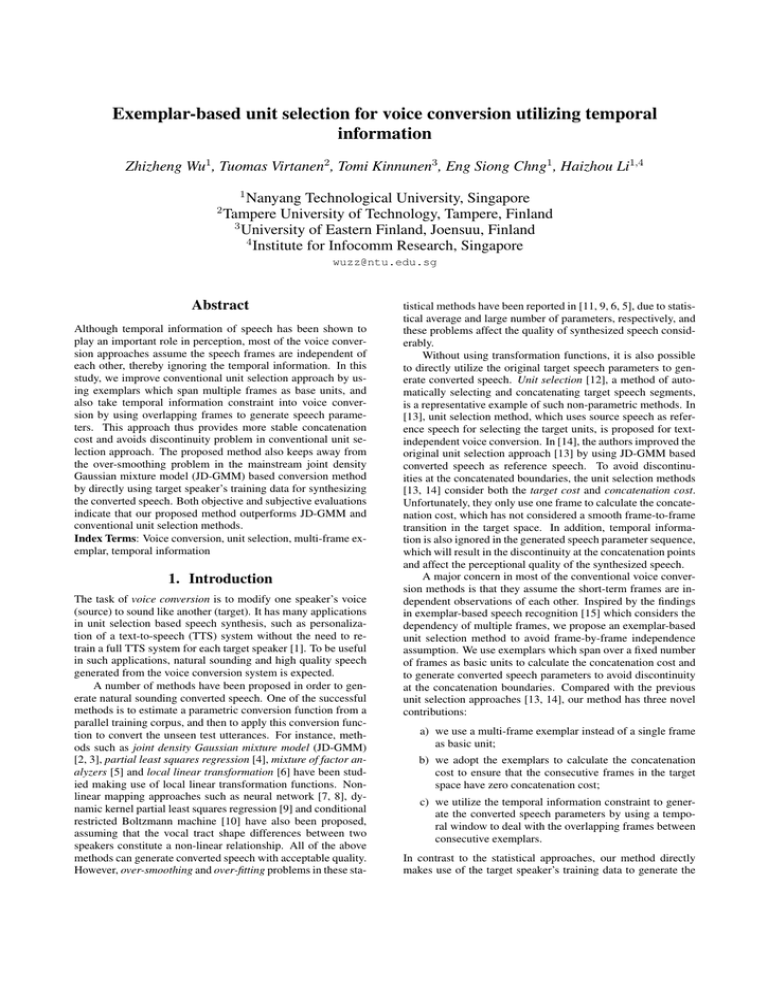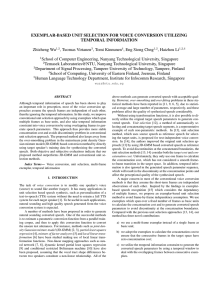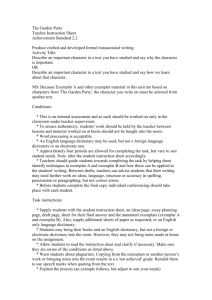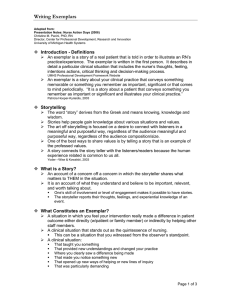Exemplar-based unit selection for voice conversion
advertisement

Exemplar-based unit selection for voice conversion utilizing temporal
information
Zhizheng Wu1 , Tuomas Virtanen2 , Tomi Kinnunen3 , Eng Siong Chng1 , Haizhou Li1,4
1
2
Nanyang Technological University, Singapore
Tampere University of Technology, Tampere, Finland
3
University of Eastern Finland, Joensuu, Finland
4
Institute for Infocomm Research, Singapore
wuzz@ntu.edu.sg
Abstract
Although temporal information of speech has been shown to
play an important role in perception, most of the voice conversion approaches assume the speech frames are independent of
each other, thereby ignoring the temporal information. In this
study, we improve conventional unit selection approach by using exemplars which span multiple frames as base units, and
also take temporal information constraint into voice conversion by using overlapping frames to generate speech parameters. This approach thus provides more stable concatenation
cost and avoids discontinuity problem in conventional unit selection approach. The proposed method also keeps away from
the over-smoothing problem in the mainstream joint density
Gaussian mixture model (JD-GMM) based conversion method
by directly using target speaker’s training data for synthesizing
the converted speech. Both objective and subjective evaluations
indicate that our proposed method outperforms JD-GMM and
conventional unit selection methods.
Index Terms: Voice conversion, unit selection, multi-frame exemplar, temporal information
1. Introduction
The task of voice conversion is to modify one speaker’s voice
(source) to sound like another (target). It has many applications
in unit selection based speech synthesis, such as personalization of a text-to-speech (TTS) system without the need to retrain a full TTS system for each target speaker [1]. To be useful
in such applications, natural sounding and high quality speech
generated from the voice conversion system is expected.
A number of methods have been proposed in order to generate natural sounding converted speech. One of the successful
methods is to estimate a parametric conversion function from a
parallel training corpus, and then to apply this conversion function to convert the unseen test utterances. For instance, methods such as joint density Gaussian mixture model (JD-GMM)
[2, 3], partial least squares regression [4], mixture of factor analyzers [5] and local linear transformation [6] have been studied making use of local linear transformation functions. Nonlinear mapping approaches such as neural network [7, 8], dynamic kernel partial least squares regression [9] and conditional
restricted Boltzmann machine [10] have also been proposed,
assuming that the vocal tract shape differences between two
speakers constitute a non-linear relationship. All of the above
methods can generate converted speech with acceptable quality.
However, over-smoothing and over-fitting problems in these sta-
tistical methods have been reported in [11, 9, 6, 5], due to statistical average and large number of parameters, respectively, and
these problems affect the quality of synthesized speech considerably.
Without using transformation functions, it is also possible
to directly utilize the original target speech parameters to generate converted speech. Unit selection [12], a method of automatically selecting and concatenating target speech segments,
is a representative example of such non-parametric methods. In
[13], unit selection method, which uses source speech as reference speech for selecting the target units, is proposed for textindependent voice conversion. In [14], the authors improved the
original unit selection approach [13] by using JD-GMM based
converted speech as reference speech. To avoid discontinuities at the concatenated boundaries, the unit selection methods
[13, 14] consider both the target cost and concatenation cost.
Unfortunately, they only use one frame to calculate the concatenation cost, which has not considered a smooth frame-to-frame
transition in the target space. In addition, temporal information is also ignored in the generated speech parameter sequence,
which will result in the discontinuity at the concatenation points
and affect the perceptional quality of the synthesized speech.
A major concern in most of the conventional voice conversion methods is that they assume the short-term frames are independent observations of each other. Inspired by the findings
in exemplar-based speech recognition [15] which considers the
dependency of multiple frames, we propose an exemplar-based
unit selection method to avoid frame-by-frame independence
assumption. We use exemplars which span over a fixed number
of frames as basic units to calculate the concatenation cost and
to generate converted speech parameters to avoid discontinuity
at the concatenation boundaries. Compared with the previous
unit selection approaches [13, 14], our method has three novel
contributions:
a) we use a multi-frame exemplar instead of a single frame
as basic unit;
b) we adopt the exemplars to calculate the concatenation
cost to ensure that the consecutive frames in the target
space have zero concatenation cost;
c) we utilize the temporal information constraint to generate the converted speech parameters by using a temporal window to deal with the overlapping frames between
consecutive exemplars.
In contrast to the statistical approaches, our method directly
makes use of the target speaker’s training data to generate the
′
(t)
converted speech, which will avoid both over-smoothing and
over-fitting problems.
We summarize the process as follows. We first find sourcetarget exemplar pairs on parallel training data; we then select
several target candidate exemplars for each source exemplar in
a test sentence and calculate the target cost and the concatenation cost; after that Viterbi algorithm is adopted to find the
optimal target exemplar sequence which minimizes the overall
target and concatenation costs; finally, the converted speech parameters are generated from the overlapping exemplars by considering temporal information constraint.
where X(t) (i, d) and Yk (i, d) are the d-th dimension ele′
(t)
ments of the i-th frame vector of exemplars X(t) and Yk at
time t, respectively.
After the shortlisted candidate exemplars are chosen, we
calculate the target-to-target concatenation cost as follows:
2. Exemplar-based Unit Selection
where Yk (l + 1, d) is the d-th dimension element of (l + 1)th frame vector of the k-th candidate at time t. We note that if
two exemplars are exactly the neighbours in the training set, the
concatenation cost will be 0, because the (q − 1) frames used
for calculation are exactly the same.
′
(t)
If the window size is one (q = 1), Yk becomes a Ddimensional vector. In this special case, the concatenation cost
is:
′
(t+1)
′
′
(t)
)=
(t+1)
X(n) = [xnx −p , xnx −p+1 , ..., xnx , ..., xnx +p−1 , xnx +p ] ∈ Rq×D
for source and
Y(n) = [yny −p , yny −p+1 , ..., yny , ..., yny +p−1 , yny +p ] ∈ Rq×D
for target, where q = 2p + 1 is the window size of an exemplar.
We note that two consecutive exemplars X(n) and X(n+1) have
(q − 1) overlapping frames. We note that there are no repeated
frames within an exemplar.
2.2. Pre-selection of candidate exemplars
Note that we obtain exemplar pairs from parallel training
data. At run-time testing, for each source exemplar Xt =
[xt−p , xt−p+1 ,
..., xt , ..., xt+p−1 , xt+p ] in the testing sentence, we pre-select
several target exemplars as candidates.
′
(t)
′
(t)
We first find the K nearest neighbors X1 , ..., XK in the
source training data for each X(t) . The paired target exemplars
′
′
′
′
(t)
(t)
(t)
(t)
Y1 , ..., YK corresponding to X1 , ..., XK are then selected based on the source-target exemplars pairing in the previous step. Thus, the target cost for each candidate is calculated
as follows:
q
D
∑
∑
′
(t)
(X(t) (i, d) − Yk (i, d))2 ,
i=1 d=1
(1)
(l, d))2 ; j = 1, .., K
(2)
l=1 d=1
(t)
′
(t)
′
(t+1)
Cconcatenation (Yk , Yj
′
′
(t)
)=
(t+1)
(Yk (d) − Yj
Given a parallel data, source frame sequence X = [x1 , x2 , ...,
xnx , ..., xNx ] and target frame sequence Y
=
[y1 , y2 , ..., yny ,
..., yNy ], dynamic time warping (DTW) is performed to obtain
aligned frames. The alignment produces the joint vector
⊤ ⊤
sequence Z = [z1 , z2 , ..., zN ], where zn = [x⊤
nx , yny ] ,
D
D
2D
xnx ∈ R , yny ∈ R and zn ∈ R . Hence, the exemplar
pair at time n is
(t)
(t)
(Yk (l + 1, d) − Yj
D
∑
2.1. Source-target exemplars pairing
′
q−1 D
∑
∑
′
An exemplar is a time-frequency speech segment which spans
over multiple consecutive frames. Exemplar-based methods
have been popular in modern speech recognition [15], as they
allow modelling of the temporal information. Different from
the template-based speech recognition [16] and unit selection
for concatenative speech synthesis [12] which employ transcription label to obtain the template or unit, we use exemplars with
fixed number of frames similar as [17], because the transcription information is not available in this study.
Ctarget (X(t) , Yk ) =
′
Cconcatenation (Yk , Yj
(d))2 ; j = 1, ..., K.
(3)
d=1
This is the same as the calculation of conventional concatenation cost, which can not guarantee the cost to be 0 when the two
frames are exactly neighbours, as two consecutive frames may
not be exactly the same.
2.3. Searching for the optimal exemplar sequence
Given a source exemplar sequence X(1) , ..., X(t) , ..., X(T )
from a testing sentences, K target exemplars for each source
exemplar are pre-selected, and the target cost and the concatenation cost are all calculated as introduced in the previous step.
Then, the optimal target exemplar sequence can be found by
minimizing the following cost function:
Ỹ (1) , ..., Ỹ(T ) = arg
min
k=1,...,K
T
∑
′
(t)
{Ctarget (X(t) , Yk )
t=1
′
(t)
′
(t+1)
+ Cconcatenation (Yk , Yj
)}; j = 1, ..., K.
(4)
In practice, this is achieved by using Viterbi search, as illustrated in Fig. 1.
2.4. Speech parameter generation
Although the exemplar sequence is obtained using Viterbi
search, we can not directly pass the exemplar sequence to the
synthesis filter to reconstruct the speech signal, because there
are overlapping frames between consecutive exemplars. The
overlapping frames contain temporal information that is beneficial for a smooth signal re-construction. To take advantage
of such temporal information, we introduce a weight for each
frame in an exemplar, which forms a temporal window.
a = [p, p − 1, ..., 0, ..., p − 1, p],
(5)
w = exp(−λ|a|),
(6)
where λ is a scalar value to control the shape of the temporal
window. We normalize the weight vector w to make sure the
to RMS (M2M), BDL to SLT (M2F), SLT to CLB (F2F) and
SLT to RMS (F2M).
The speech signal, sampled at 16 kHz, is analyzed using
STRAIGHT [18] with 5ms shift. 24-order mel-cepstral coefficients (MCC), excluding the 0th energy coefficient, are extracted. The MCCs are converted by using each of the conversion method detailed in the following paragraph, while logscale F0 is converted by equalizing the means and variances of
the source and the target speakers.
In this work, we compare the following four approaches:
Figure 1: Illustration of searching for the optimal exemplar
sequence. In the figure, dashed line (connecting X(t) and
′
′
(t)
(t)
Yk ) represents target cost and solid line (connecting Yk
′
(t+1)
and Yj
) represents concatenation cost.
elements sum to 1. The converted speech parameters are generated as follows:
y˜(t) =
q
∑
Ỹ(t−p+i−1) (q − i + 1) × w(q − i + 1)
(7)
i=1
where Ỹ(t−p+i−1) (q −i+1) is the (q −i+1)-th column vector
of Ỹ(t−p+i−1) , and w(q − i + 1) is the (q − i + 1)-th element
of w.
a) Joint density Gaussian mixture model (JD-GMM): This
is the mainstream voice conversion method [2, 3]. We
adopt 64 full covariance Gaussian components to model
the joint distribution of source and target speech. This is
our first baseline method.
b) Unit selection (US) [13, 14]: This is the conventional
unit selection approach, using only one frame to calculate both the target and the concatenation costs. This is
our second baseline method.
c) Partial exemplar-based unit selection (PEUS): The
method follows the steps as described in section 2.1, 2.2
and 2.3. While in the generation step, only the center
frame in an exemplar is chosen to generate the converted
speech parameters. It is an intermediate method towards
our proposed method.
d) Exemplar-based unit selection (EUS): This method is the
proposed method as detailed in previous section.
0.5
Lambda = 0.0
Lambda = 0.1
Lambda = 0.2
Lambda = 0.5
Lambda = 1.0
0.45
0.4
0.35
3.1. Objective evaluation
To evaluate the performance objectively, we adopt mel-cepstral
distortion [2, 3] as an objective evaluation measure:
Weight
0.3
0.25
MCD =
0.2
0.15
0
0
2
4
6
8
Frame index in an exemplar
10
12
Figure 2: The temporal window with different λ
Fig. 2 shows the shape of the temporal window for different values of λ. As we increase λ, the contribution of the center frame to the converted speech parameter increases as well.
While choosing large enough λ is similar as choosing only the
center frame as the converted speech parameter. Conversely, decreasing λ means considering more temporal information, and
λ = 0.0 corresponds to merely averaging all the overlapped
frames.
If we set the center element of w to one and the rest elements to zero, in other words, only the center frame in an exemplar is used as the converted speech parameter, this will reduce
the method to a scheme which does not take into consideration
of temporal information constraint in the synthesis and only in
finding the optimal sequence of exemplars.
3. Experiments
The CMU ARCTIC corpus is adopted for the experiments. Two
male (BDL, RMS) and two female (SLT, CLB) speakers are selected. 200 utterances of each speaker are used as training data,
and 20 utterances of each speaker are used as testing data. We
conduct both inter-gender and intra-gender conversions: BDL
√
t
c 2
2Σ24
i=0 (mci − mci ) ,
(8)
where mct and mcc are the target and converted MCCs, respectively. The lower of the MCD value, the smaller distortion.
We first study the effects of the window size of an exemplar
(q) and the number of shortlisted candidates (K). Here we only
use the center frame in the exemplar without any overlapping
constraints to generate converted speech.
5.64
100 shortlisted candidates
200 shortlisted candidates
300 shortlisted candidates
400 shortlisted candidates
5.62
5.6
Spectral distortion
0.1
0.05
10
ln 10
5.58
5.56
5.54
5.52
5.5
3
5
7
9
11
13
15
Window size of exemplar
17
19
21
Figure 3: Spectral distortion as a function of window size of an
exemplar and number of shortlist candidates in terms of spectral
distortion (dB).
Fig. 3 indicates that window size of q = 9 can give lowest distortion consistently. Distortion decreases with increased
shortlist size as expected, but comes with an added computational overhead. Since there is not much change beyond 200
5.29
3.5
5.26
3
5.25
2.5
5.24
MOS
Spectral distortion (dB)
5.27
EUS
GMM
US
2
5.23
1.5
5.22
1
5.21
5.2
0.0
0.1
0.2
0.4
Value of λ
0.6
0.8
EUS
GMM
70
60
Preference score (%)
5.28
50
40
30
20
0.5
10
0
0
1.0
Figure 4: Distortion as a function of λ.
(a) Overall quality results
candidates, we fix K = 200 and q = 9 for the rest of the experiments.
We now turn our attention to the temporal window. As
shown in Eq. (6), we use λ to control the shape of the temporal
window for an exemplar. The distortion with different values of
λ are shown in Fig. 4. When λ ≥ 0.4, the distortion increases.
When λ < 0.2, the distortion also increases. Therefore, we
empirically fix λ = 0.2 for the rest of the experiments.
Table 1: Spectral distortion comparison of the baselines and the
proposed exemplar-based unit selection (EUS) method
JD-GMM
US
PEUS
EUS
M2M
5.28
6.25
5.57
5.26
M2F
5.60
6.69
5.90
5.57
F2F
4.82
5.62
5.04
4.77
F2M
5.34
6.39
5.52
5.21
Average
5.26
6.24
5.51
5.20
Comparison of the proposed method with the two baseline
methods and PEUS method is given in Table 1. Comparing with
US and PEUS, PEUS gives lower spectral distortion and we can
see the advantage of using multiple frames exemplar to do preselection and to calculate the target cost and concatenation cost
for searching the optimal frame sequence. The benefit of using a
temporal window to include temporal information constraint in
the converted speech parameter generation can be seen by comparing the results of PEUS and EUS. The difference of PEUS
and EUS methods is that EUS employs a temporal window to
deal with overlapping frames between consecutive exemplars
while PEUS does not. JD-GMM method also gives higher spectral distortion than the proposed EUS method for both male and
female source speakers. In general, the proposed method (EUS)
has lower spectral distortion than both JD-GMM and US methods. We note again that the lower spectral distortion, the better
performance.
3.2. Subjective evaluation
To assess the overall quality of converted speech, we conducted
subjective evaluation using mean opinion score (MOS). We
compare the proposed EUS method with the two baseline methods: JD-GMM and US. As PEUS is an intermediate method
towards EUS, it is excluded in the subjective evaluation. We
randomly select 5 sentences from JD-GMM conversion, US
conversion and EUS conversion speech of four conversion directions (M2M, M2F, F2F and F2M). As a result, there are 20
sentences for each method and 60 sentences in the whole test.
These speech samples were presented to 9 subjects. The subjects were asked to listen to each speech sample and then rate
the speech quality based on a five point scale: 5 for perfect, 4
(b) Similarity results
Figure 5: Subjective evaluation results with 95% confidence interval
for good, 3 for fair, 2 for poor, and 1 for bad. The MOS is
obtained by average all the scores rated by all the subjects. The
MOS results are presented in Fig. 5(a). We can see that our
proposed method outperforms both JD-GMM and conventional
unit selection method in terms of perceptual quality. The proposed temporal window in EUS method is able to smooth the
converted trajectory, while the US method without such temporal window can not.
An AB preference test was also conducted to access the
similarity of the converted speech. As the bad quality of US
converted speech affect the similarity test, we only compare the
proposed EUS method with baseline JD-GMM method. 9 subjects were asked to listen to a reference target speech and one
pair converted speech (A and B), and decide to choose which
speech sample, A or B, is more similar to the reference target
speech. The preference results are shown in Fig. 5(b). It clearly
shows that the proposed EUS method can generate speech to
sound more similar to the target speaker than the conventional
JD-GMM method. We note that EUS method directly select target frames to compose the converted speech. Thus, it is easy
to understand that it generates speech more similar to target
speaker than JD-GMM based conversion does, the latter employs a transformation function to transform the source speech
to the target space.
4. Conclusions
In this paper, to avoid the frame-by-frame independence assumption in most the voice conversion methods, we proposed
exemplar-based unit selection method to model the temporal
dependency and take into consideration of temporal information constraint in both the process of finding the optimal exemplar sequence and generation of converted speech parameters.
By using multi-frame exemplars, the proposed method avoids
the discontinuity at the concatenation point in conventional unit
selection approaches. In addition, our method also avoids the
over-smoothing problem in the popular JD-GMM approach because the target speaker’s training data is directly used to generate the converted speech. Generally, the proposed method has
lower spectral distortion, and also generates perceptually better
speech than baseline methods.
5. Acknowledgement
This work was supported by Academy of Finland (projects no.
132129, 253120, 258708). The authors would like to thank all
the listeners who take part in the subjective evaluation test.
6. References
[1] Y. Stylianou, “Voice transformation: a survey,” in ICASSP
2009.
[2] Y. Stylianou, O. Cappé, and E. Moulines, “Continuous probabilistic transform for voice conversion,” IEEE
Transactions on Speech and Audio Processing, vol. 6, no.
2, pp. 131–142, 1998.
[3] T. Toda, A.W. Black, and K. Tokuda, “Voice conversion
based on maximum-likelihood estimation of spectral parameter trajectory,” IEEE Transactions on Audio, Speech,
and Language Processing, vol. 15, no. 8, pp. 2222–2235,
2007.
[4] E. Helander, T. Virtanen, J. Nurminen, and M. Gabbouj,
“Voice conversion using partial least squares regression,”
IEEE Transactions on Audio, Speech, and Language Processing, vol. 18, no. 5, pp. 912–921, 2010.
[5] Z. Wu, T. Kinnunen, E. Chng, and H. Li, “Mixture of
factor analyzers using priors from non-parallel speech for
voice conversion,” Signal Processing Letters, IEEE, vol.
19, no. 12, pp. 914–917, 2012.
[6] V. Popa, H. Silen, J. Nurminen, and M. Gabbouj, “Local
linear transformation for voice conversion,” in ICASSP
2012.
[7] M. Narendranath, H.A. Murthy, S. Rajendran, and B. Yegnanarayana, “Transformation of formants for voice conversion using artificial neural networks,” Speech communication, vol. 16, no. 2, pp. 207–216, 1995.
[8] S. Desai, A.W. Black, B. Yegnanarayana, and K. Prahallad, “Spectral mapping using artificial neural networks for
voice conversion,” IEEE Transactions on Audio, Speech,
and Language Processing, vol. 18, no. 5, pp. 954–964,
2010.
[9] E. Helander, H. Silén, T. Virtanen, and M. Gabbouj,
“Voice conversion using dynamic kernel partial least
squares regression,” IEEE Transactions on Audio, Speech,
and Language Processing, vol. 20, no. 3, pp. 806–817,
2012.
[10] Z. Wu, E. S. Chng, and H. Li, “Conditional restricted
boltzmann machine for voice conversion,” in the IEEE
China Summit and International Conference on Signal
and Information Processing (ChinaSIP) 2013.
[11] Y. Chen, M. Chu, E. Chang, J. Liu, and R. Liu, “Voice
conversion with smoothed GMM and MAP adaptation,”
in Eurospeech-2003.
[12] A.J. Hunt and A.W. Black, “Unit selection in a concatenative speech synthesis system using a large speech
database,” in ICASSP 1996.
[13] D. Sundermann, H. Hoge, A. Bonafonte, H. Ney,
A. Black, and S. Narayanan, “Text-independent voice
conversion based on unit selection,” in ICASSP 2006.
[14] T. Dutoit, A. Holzapfel, M. Jottrand, A. Moinet, J. Perez,
and Y. Stylianou, “Towards a voice conversion system
based on frame selection,” in ICASSP 2007.
[15] T.N. Sainath, B. Ramabhadran, D. Nahamoo,
D. Kanevsky, D. Van Compernolle, K. Demuynck,
J.F. Gemmeke, J.R. Bellegarda, and S. Sundaram,
“Exemplar-based processing for speech recognition: An
overview,” IEEE Signal Processing Magazine, vol. 29,
no. 6, pp. 98 –113, nov. 2012.
[16] M. De Wachter, M. Matton, K. Demuynck, P. Wambacq,
R. Cools, and D. Van Compernolle, “Template-based continuous speech recognition,” Audio, Speech, and Language Processing, IEEE Transactions on, vol. 15, no. 4,
pp. 1377–1390, 2007.
[17] J.F. Gemmeke, T. Virtanen, and A. Hurmalainen,
“Exemplar-based sparse representations for noise robust
automatic speech recognition,” Audio, Speech, and Language Processing, IEEE Transactions on, vol. 19, no. 7,
pp. 2067–2080, 2011.
[18] H. Kawahara, I. Masuda-Katsuse, and A. de Cheveigné,
“Restructuring speech representations using a pitchadaptive time–frequency smoothing and an instantaneousfrequency-based f0 extraction: Possible role of a repetitive
structure in sounds,” Speech communication, vol. 27, no.
3, pp. 187–207, 1999.


